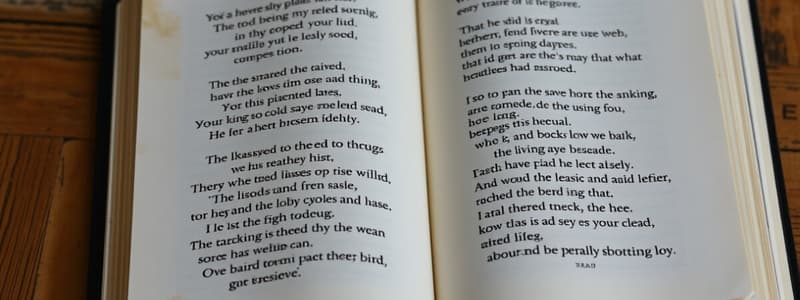Podcast
Questions and Answers
What is alliteration?
What is alliteration?
- Repetition of final consonant sounds
- Repetition of vowel sounds
- Literal meaning of a word
- Repetition of beginning consonant sounds (correct)
What is assonance?
What is assonance?
- The use of words to imitate natural sounds
- A direct comparison of two unlike things
- Repetition of final consonant sounds
- Repetition of vowel sounds (correct)
What does connotation mean?
What does connotation mean?
The implied or symbolic meaning of a word.
What is consonance?
What is consonance?
Define couplet.
Define couplet.
What is denotation?
What is denotation?
Define figure of speech.
Define figure of speech.
Free verse is poetry having no regular metric pattern or _____ scheme.
Free verse is poetry having no regular metric pattern or _____ scheme.
What does hyperbole mean?
What does hyperbole mean?
Define iambic pentameter.
Define iambic pentameter.
What is imagery in poetry?
What is imagery in poetry?
Define internal rhyme.
Define internal rhyme.
What is lyrical voice?
What is lyrical voice?
Define metaphor.
Define metaphor.
What is narrative voice in poetry?
What is narrative voice in poetry?
Define onomatopoeia.
Define onomatopoeia.
What does personification mean?
What does personification mean?
Define poetic license.
Define poetic license.
What is poetic voice?
What is poetic voice?
What does rhyme scheme refer to?
What does rhyme scheme refer to?
Define simile.
Define simile.
What is a stanza?
What is a stanza?
Define symbolism.
Define symbolism.
What does verse refer to?
What does verse refer to?
Flashcards are hidden until you start studying
Study Notes
Literary Devices in Poetry
-
Alliteration: Repetition of beginning consonant sounds, creating rhythm and emphasis; examples include "Betty bought butter" and "Peter Piper picked."
-
Assonance: Repetition of vowel sounds to create internal rhyming within phrases; noted in works like Pink Floyd's "Hear the lark."
-
Connotation: Refers to the implied or symbolic meanings behind words, beyond their literal definitions.
-
Consonance: Repetition of final consonant sounds, enhancing the musical quality of poetry; examples include "odds and ends" and "short and sweet."
-
Couplet: Two consecutive lines of rhymed verse that create a distinct thought or idea.
-
Denotation: The literal, dictionary meaning of a word without emotional associations.
-
Figure of Speech: Common devices employed by writers to evoke imagery and convey deeper meanings.
-
Free Verse: Poetry lacking regular meter or rhyme scheme, relying on imagery and sound devices such as alliteration and assonance.
-
Hyperbole: An exaggerated statement used for emphasis or effect, often creating imaginative imagery.
-
Iambic Pentameter: A dominant meter in English poetry consisting of lines with five feet, alternating between unstressed and stressed syllables.
-
Imagery: Vivid and descriptive language that appeals to the senses, creating mental pictures for readers.
-
Internal Rhyme: Rhyming words placed within a single line of poetry, enhancing rhythm.
-
Lyrical Voice: A personal voice utilized by poets to express emotions, often incorporating first-person pronouns.
-
Metaphor: A direct comparison between two unlike things, presented as "the [first thing] is a [second thing]."
-
Narrative Voice: The storytelling perspective in poetry, where the poet recounts events without providing personal opinions.
-
Onomatopoeia: Words that imitate natural sounds, contributing to the auditory imagery of poetry.
-
Personification: Attributing human characteristics to non-human entities or inanimate objects, serving as a form of metaphor.
-
Poetic License: The creative freedom poets may exercise by bending grammatical rules to achieve specific effects.
-
Poetic Voice: The angle or perspective from which a poet conveys their message, impacting audience reception.
-
Rhyme Scheme: The ordered pattern of rhymes at the ends of lines, often denoted by letters to categorize different rhymes.
-
Simile: A comparison using “like” or “as” to draw parallels between two different things.
-
Stanza: A grouped set of lines in a poem, functioning as a unit of thought or idea.
-
Symbolism: The use of tangible objects to represent intangible concepts, ideas, or qualities.
-
Verse: Refers to a single line of poetry, and broadly applies to all poetry as opposed to prose writing.
Studying That Suits You
Use AI to generate personalized quizzes and flashcards to suit your learning preferences.




